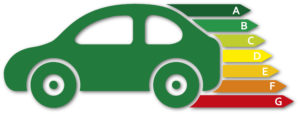INFORMING CONSUMERS ABOUT THE ENVIRONMENTAL PERFORMANCE OF CARS
UPDATING LEGISLATION TO ENSURE THAT CONSUMERS RECEIVE THE INFORMATION THAT THEY NEED
The cars that we drive are changing. There is an increasing range of plug-in hybrid, battery electric and even hydrogen-powered cars on the market. At the same time, consumers are using the internet much more to research potential car purchases and even to buy cars. EU legislation from 1999 currently sets the framework for the provision of information to consumers on the environmental performance of new cars. This was adopted at a time when there were no mass market electric vehicles and when the use of the internet was still in its infancy. TEPR supported the European Commission in reviewing potential policy measures to keep consumers better informed, taking account of developments in the last 20 years.
Existing EU legislation
EU Directive 1999/94 requires that information on new cars’ CO2 emissions and fuel consumption is made available to consumers, particularly in car showrooms. The aim was to ensure that consumers were aware of, and able to understand and compare, the environmental performance of different cars and so were able to take account of this information in their purchase decision, if they wished to do so.
The primary means of communicating this information is a label that has to be attached to (or be displayed near) new cars in car showrooms, while the information also needs to be included in a printed guide and in printed promotional material. The Directive is one of many pieces of EU legislation, including that on reducing CO2 emissions from cars and vehicle taxation, that together form a policy framework to reduce transport’s CO2 emissions, which is one of the greenhouse gases that contribute to climate change.
The changing car market
Directive 1999/94 has not been updated significantly since its adoption in 1999. However, the car market has changed a lot. In recent years, an increasing number of models of plug-in hybrid cars, battery electric cars and even cars powered by hydrogen have come onto the market. With some countries planning to phase out the sale of new petrol and diesel cars by 2035, the new car market is going to continue to change. It is important that consumers are aware of the advantages of, and differences between, cars that use electricity or hydrogen, and those that use petrol or diesel.
Potential changes to the EU legislation
Since its adoption, TEPR has been involved in a number of reports on the implementation of Directive 1999/94, including a 2010 report for the European Parliament, a 2011 report on the Directive’s implementation for the European Commission and a 2016 evaluation of the legislation. These have all noted the increasing importance of the internet as a source of information for consumers when they research new cars, and noted the lack of provisions on electric vehicles in particular in the Directive. In addition, each report has considered other potential changes to the legislation, including the potential extension of the legislation to used cars and new vans, which could help to reduce transport’s CO2 emissions.
The importance of consumers having the right information when they need it
It is important that the way in which information is provided to consumers, and the information that is given, reflects the changes in the car market and the increased importance of the internet as a source of information for consumers. In 2020/1, TEPR was part of a consortium (led by Ricardo) that supported the Commission in identifying the most appropriate means of communicating environmental information to potential car buyers, as well as what this information should consist of, with a view to potentially amending the existing EU Directive.
Further information
TEPR is an independent research consultancy that works on projects to improve the environmental performance of transport. For more information on the project, or TEPR’s work more generally, please contact Ian Skinner at TEPR (ian.skinner@tepr.co.uk), call +44 (0)7521 063324 or see TEPR’s website. The project’s final report is also accessible from the ‘Consumer information and behaviour’ page of TEPR’s website, where TEPR’s other work on the Directive can also be found.


Leave a Reply
Want to join the discussion?Feel free to contribute!